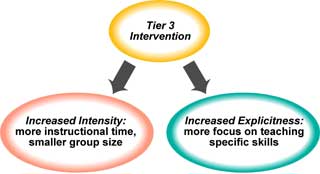How can Tier 3 intervention be conceptualized in the RTI approach?
Page 3: Qualities of Tier 3 Intervention
Although most students respond to Tier 1 or Tier 2 instruction, a small percentage (i.e., 5%) will not and may require Tier 3 intervention (i.e., special education services). In a three-tiered model, a special education teacher provides the intervention, which is guided by data, individualized, and recursive.
recursive
In this context, recursive refers to a “test-teach-test-teach” process through which an instructor uses student performance data to fine-tune his or her instruction. This instruction often changes in order to determine the most effective way of accelerating student performance.
Listen as Lynn Fuchs elaborates on the need among some students for the more intensive, individualized intervention available in Tier 3 (time: 0:50).

Lynn Fuchs, PhD
Nicholas Hobbs Endowed Chair in Special Education and Human Development
Vanderbilt University, Nashville, TN
Transcript: Lynn Fuchs, PhD
I think that when the Tier 2 program is a validated protocol, it is a standard form of instruction that we know most children can be expected to respond to. And when a child doesn’t respond to that, what that tells us is that the child needs an individualized program, a non-standard form of instruction that’s tailored to that child. And that seems to me to be by definition a special education. If you have a really good standard protocol for Tier 2, we know that some small proportion of kids will not respond to that. They need an individualized program, and that’s what special education teachers need to be doing.
 Tier 3 instruction differs from that provided in Tiers 1 or 2 in these ways:
Tier 3 instruction differs from that provided in Tiers 1 or 2 in these ways:
- Increased intensity –– more instructional time, smaller group size
- Increased explicitness –– more focus on teaching specific skills
Another way to increase the intensity of Tier 3 intervention is to group students according to their instructional needs. For example, three students who have difficulty with reading comprehension could receive instruction together in a small group.
Additional characteristics of Tier 3 intervention, some of which are shared by Tiers 1 and 2, include:
| High-quality instruction |
|
|
Five Core Reading Components Phonemic awareness: the ability to listen to, identify, and manipulate phonemes—the smallest units of sounds that are combined to create words. Phonics and word study: phonics instruction teaches students about the relationship between sounds and written letters (known as the alphabetic principle) so that they learn how to decode and read words. In word study instruction, students learn to use complex elements of reading to decode more advanced words (e.g., students learn how to decode words based on associated word meanings and by learning how to identify word parts, such as affixes and root words). The combination of phonics and word study helps students to improve their word recognition, reading, and spelling. Reading comprehension: the ability to understand written text. Vocabulary: the knowledge of words and what they mean. Reading fluency: the ability to read text with accuracy, speed, and intonation. |
|
| Frequent progress monitoring |
|
| Data-based decision making |
|
| Low student-teacher ratio |
|
For Your Information
Providing multiple rounds of intervention in Tier 2 is not the same as increasing the intensity of intervention. It is a way of providing the intervention for a longer period of time (i.e., increased duration). Students who respond well to intervention, but who need more time to meet grade-level expectations, may benefit from another round of intervention.
round of intervention
A round of intervention is a set period during which an intervention is implemented. For example, one round of Tier 2 intervention may last 12 weeks.
 In their search for information, Katy Stromwell and others from her district’s team visit Rosa Parks Elementary, a school in a neighboring district that has enjoyed success with the RTI approach. Rosa Parks has adopted a three-tiered RTI model. The team observes Rosa Parks’s implementation of Tier 3, which is special education. At Rosa Parks Elementary, a student who does not respond adequately to Tier 2 intervention is referred for a special education evaluation. If the IEP team determines, based on the evaluation results, that the student meets the criteria for a learning disability, he or she will receive special education services as the Tier 3 intervention. These intervention services are delivered by the special education teacher. Now that Katy Stromwell and the team have learned the basic procedures related to Tier 3, they find that they want even more specific information about:
In their search for information, Katy Stromwell and others from her district’s team visit Rosa Parks Elementary, a school in a neighboring district that has enjoyed success with the RTI approach. Rosa Parks has adopted a three-tiered RTI model. The team observes Rosa Parks’s implementation of Tier 3, which is special education. At Rosa Parks Elementary, a student who does not respond adequately to Tier 2 intervention is referred for a special education evaluation. If the IEP team determines, based on the evaluation results, that the student meets the criteria for a learning disability, he or she will receive special education services as the Tier 3 intervention. These intervention services are delivered by the special education teacher. Now that Katy Stromwell and the team have learned the basic procedures related to Tier 3, they find that they want even more specific information about:
individualized education program (IEP) team
A multidisciplinary group of education and related services professionals, students with disabilities, and parents, the IEP team develops and evaluates the individualized education program for each student with a disability.
- How students are identified for Tier 3 intervention
- How Tier 3 reading interventions are provided
- How students discontinue Tier 3 intervention